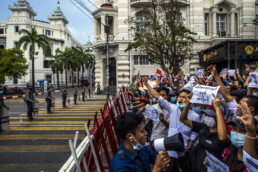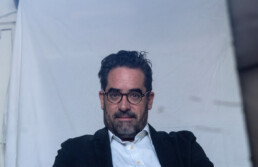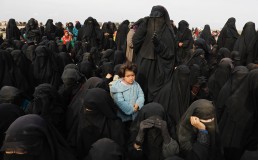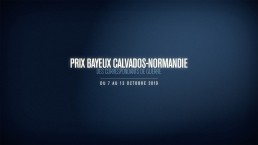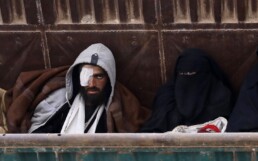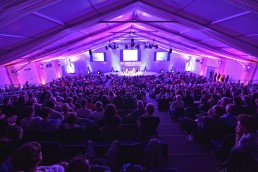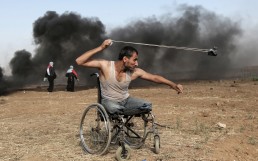Booking Award ceremony
The ceremony hosted by Nicolas Poincaré will be the opportunity to review the major events of this past year. Documentaries made especially for this event will be shown throughout the evening. The public will also be able to discover the award-winning reports, in the presence of the jury and a great number of journalists.
SATURDAY 12 OCTOBER, 6.30 pm
Pavillon Prix Bayeux-Calvados
Place Gauquelin Despallières
Doors open at 5 pm
Booking required
If you are unable to attend at the last minute, please contact us on +33 2 31 51 60 47
29th edition of the Bayeux Calvados-Normandy Award: results
More than forty war correspondents have gathered in Bayeux on October 7th and 8th to debate and award trophies in the following categories: photo, print, radio, television, grand format television, young reporter (photo) and video image. Three honorary awards have been attributed: the Regional prize for students and trainees of Normandy (television), the Public’s Choice award (photo) and the Ouest-France – Jean Marin prize (print). Presided by Thomas Dworzak, the international jury of the 29th edition of the Bayeux Calvados-Normandy Award for war correspondents has reached its verdict…
“Alongside my colleagues, I discovered works of indisputable excellence. The level was so high it was difficult to decide between the reports! The deliberations were intense, essential, very nourished. To hear the arguments of my peers, of whom I respect the work, will remain an unforgettable experience for me.“
Thomas Dworzak
PHOTO TROPHY – INTERNATIONAL JURY
AWARDED BY NIKON
1st Prize
Evgeniy MALOLETKA
ASSOCIATED PRESS
A Siege in Mariupol
UKRAINE
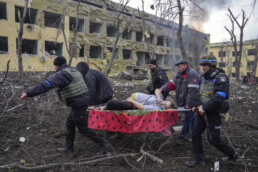
2nd Prize
Yasuyoshi CHIBA
AFP
Les rebelles reprennent la capitale du Tigré
MEKELE, ETHIOPIA
3rd Prize
Vadim GHIRDA
ASSOCIATED PRESS
War in Ukraine
UKRAINE
TELEVISION TROPHY – INTERNATIONAL JURY
AWARDED BY AMNESTY INTERNATIONAL
1st Prize
Théo MANEVAL and Pierre DEHOORNE
France 5 – C dans l’air
Viktor et le baiser de la guerre
UKRAINE
2nd Prize
Mstyslav CHERNOV
ASSOCIATED PRESS
Marioupol – La mort d’une ville ukrainienne
UKRAINE
3rd Prize
Jeremy BOWEN and Lee DURANT
BBC
Des cadavres sur la route du cauchemar
UKRAINE
PHOTO TROPHY – PUBLIC’S CHOICE AWARD
SPONSORED BY THE FRENCH DEVELOPMENT AGENCY (AFD)
1st Prize
Vadim GHIRDA
ASSOCIATED PRESS
War in Ukraine
UKRAINE
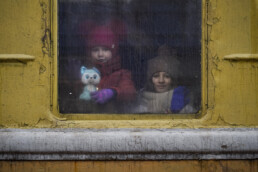
PRINT TROPHY – INTERNATIONAL JURY
AWARDED BY THE DEPARTMENT OF CALVADOS
1st Prize
Mariam OUEDRAOGO
EDITIONS SIDWAYA
Axe Dablo-Kaya : la route de l’enfer des femmes déplacées internes
BURKINA FASO
2nd Prize
Margaux BENN
LE FIGARO
En Ukraine, la rage de vivre pour vaincre l’horreur
UKRAINE
3rd Prize
Rachida EL AZZOUZI and Mortaza BEHBOUDI
MEDIAPART
À travers l’Afghanistan, six mois après le retour des talibans
AFGHANISTAN
RADIO TROPHY – INTERNATIONAL JURY
AWARDED BY THE D-DAY LANDING COMMITTEE
1st Prize
Maurine MERCIER
France INFO – RTS
Guerre en Ukraine : une mère et sa fille racontent deux semaines de viols et de terreur à Boutcha
UKRAINE
2nd Prize
Quentin SOMMERVILLE
BBC NEWS
La patrouille à pied
UKRAINE
3rd Prize
Jeremy BOWEN
BBC NEWS
Iryna Kostenko
UKRAINE
YOUNG REPORTER TROPHY (PHOTO) – INTERNATIONAL JURY
AWARDED BY CRÉDIT AGRICOLE NORMANDIE
1st Prize
Abdulmonam EASSA
Freelance for Le Monde, The New York Times, Getty Images
La rage pacifique ne meurt pas
SUDAN
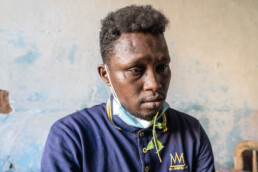
GRAND FORMAT TELEVISION TROPHY – INTERNATIONAL JURY
AWARDED BY INTERNATIONAL CRISIS GROUP
1st Prize
Philip COX
THE GUARDIAN
Le Spiderman du Soudan
SUDAN
2nd Prize
Ben C. SOLOMON
Adam DESIDERIO
VICE NEWS
Fall of Kandahar
AFGHANISTAN
VIDEO IMAGE TROPHY – INTERNATIONAL JURY
AWARDED BY ARTE, FRANCE 24, FRANCE TÉLÉVISIONS
1st Prize
Mstyslav CHERNOV
ASSOCIATED PRESS
Marioupol – La mort d’une ville ukrainienne
UKRAINE
PRINT TROPHY – OUEST-FRANCE – JEAN MARIN
1st Prize
Nicolas DELESALLE
PARIS MATCH
Ukraine : le convoi de la dernière chance
UKRAINE
TELEVISION TROPHY – REGIONAL PRIZE FOR STUDENTS AND TRAINEES OF NORMANDY
1st Prize
Dorothée OLLIERIC, Nicolas AUER and Mortaza BEHBOUDI
France 2
Les petites filles afghanes vendues pour survivre
AFGHANISTAN
Thomas Dworzak, Jury Chair for the 29th edition
Thomas Dworzak is an internationally acclaimed war photographer and a specialist in the Caucasus, who has been documenting the majority of world events since the 1990s. He has been a member of Magnum Photos since 2000 and was their president from 2017 to 2020. His work has been widely published, including by The New Yorker, Newsweek, U.S. News & World Report, Paris Match, The New York Times Magazine, Time… He won the World Press Photo award in 2001 for a report in Chechnya.
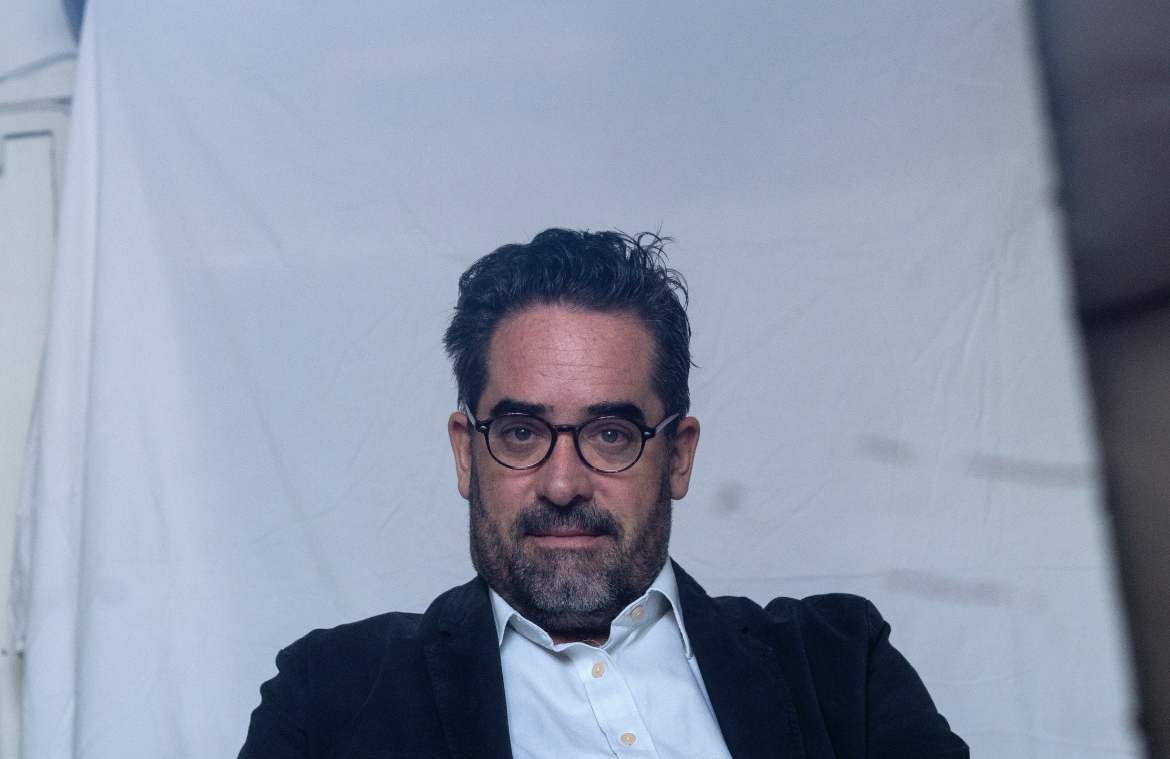 The self-taught photojournalist Thomas Dworzak (50) has spent the last thirty years travelling throughout the world, from Afghanistan to Iraq via the former Yugoslavia, Iran and the Caucasus, providing an unconventional take on the conflicts. He has been a member of the prestigious Magnum Agency since 2000 and has received many awards, notably from the World Press Photo in 2001 for his work in Chechnya.
The self-taught photojournalist Thomas Dworzak (50) has spent the last thirty years travelling throughout the world, from Afghanistan to Iraq via the former Yugoslavia, Iran and the Caucasus, providing an unconventional take on the conflicts. He has been a member of the prestigious Magnum Agency since 2000 and has received many awards, notably from the World Press Photo in 2001 for his work in Chechnya.
“I grew up in a peaceful part of Bavaria, in a provincial, very protected environment. I needed an extreme form of challenge. Photographing war is the ultimate in extreme.” Thomas Dworzak was born in Kötzting, in Germany, in 1972, and grew up in the small town of Cham, in a family of teachers. It was the height of the Cold War, and they were 7km from the iron curtain and the border with what was then Czechoslovakia.
“The wall had just come down but the East didn’t attract me. I went to Northern Ireland, Israel, Palestine. I had a vague idea of becoming a photographer. I had taken photographs but didn’t have any photographic culture or technique. It was a mixture of a wish to provoke, a desire to travel and an interest in stories, narratives, and especially the ones surrounding my maternal grandfather who had been killed in the war, and the deportation of my father’s family, which made me want to put the famous vest with pockets.”
With no network of contacts or funding, Thomas Dworzak tried to get to the former Yugoslavia, where the biggest conflict on European soil since the Second World War had just broken out. “I followed some German fascist volunteers to Croatia. I sent some small prints to the daily newspaper ’”Tageszeitung". They didn’t keep any of them.” His first break came in Prague, where he was taking language courses (he speaks French, English, Spanish and Russian). There he met the editor in chief of the only German newspaper in the city, through whom he obtained accreditation. A door-opener.
“Wostok, the smallest of the big agencies”
In 1992 he went to Moscow, and then settled in Tbilisi, in Georgia, from 1993 until 1998. “I was fascinated by the Caucasus, and spent most of my time between Grozny and Tbilisi. The Russian forces were merciless. The Chechens fought with pride. I discovered a people who were armed to the teeth, there were kalashnikovs everywhere, but they had an incredible sense of hospitality. ”He followed the conflicts in Chechnya but also in Karabakh and Abkhazia.
“In 1995, when I returned on a visit to Germany, I went to the French embassy. I asked for the yellow pages and sent applications to 40 agencies based in Paris.” Magnum politely replied that it is a cooperative with a very strict recruitment procedure. Wostok, "the smallest of the big agencies”, took him on. ”Jean-Claude Zullo and his wife, who was from Montenegro, took me under their wings. It was a small but highly respected agency. They brought me out of my isolation.” In 1999 he went to live in Paris. That same year he was called on by a friend who was a correspondent for The Guardian, and went to cover the crisis in Kosovo. “The technology boom was going on. I bought a colour scanner and a computer, and then I could be autonomous.” His work about a Serbian massacre was noticed by the U.S. News & World Report. ”I was becoming a pro. I was earning money. I was sending photos every day.”
2nd prize at Bayeux
A year later he returned to Chechnya after the Russian troops had left. “It was like day and night. Instead of being able to travel around freely as before, I had to have six bodyguards. Then an English journalist hired me as a Russian interpreter. By bringing her back to Chechnya as a fixer, I was able to take exclusive photos of the Chechen exodus. I took the best photos of my life while I was working as an interpreter.” His report “Leaving Grozny” was published by Newsweek, Paris Match, The New York Times and was awarded 2nd prize at Bayeux in 2000.
After the fall of Grozny be began work on a project looking at the impact of the war in Chechnya on the neighbouring North Caucasus. This work carried out between 1992 and 2002 was published in 2010 in the form of the book Kavkaz.
He also photographed events in Israel, the war in Macedonia, the refugee crisis in Pakistan, Baghdad under Saddam Hussein, and Iraqi Kurdistan.
Mainly based in New York since 2004, he photographed the political landscape in the USA and the consequences of the war in Iraq, to which he also devoted “M*A*S*H”, an astonishing composition combining the fictional film/series and the reality in Iraq, which was exhibited at Bayeux in 2007.
Dworzak joined the Magnum agency in 2000, becoming its president from 2017 to 2020. ”The agency wanted some new blood. I was surprised. I had thought it was only for very well established photographers, a sort of Holy Grail.”
His first book was made up of photos – that weren’t by him
After 11 September 2001 Thomas Dworzak spent several months in Afghanistan on an assignment for the New Yorker. He returned with his first book, “Taliban”. The project was surprising, provocative and subversive... The photojournalist’s project was based on portraits of members of the Taliban that he found in the back rooms of shops doing identity photos. They showed Taliban fighters against colourful, fantasy backgrounds, their eyes underlined with kohl… “First, the Taliban banned everyone from taking photos. Then they closed the photo studios, then they opened them again clandestinely, and in the end they had their photos taken. Except that no-one else was allowed to take them. So my first book is made up of photos that I didn’t take.”
Since than, he has been to Iran and Haiti. He has also produced reports on the revolutions taking place in republics of the former Soviet Union – Georgia, Kyrgyzstan and Ukraine. For his most recent project, “Feldpost” (2013-2018), he photographed the “memory” of the First World War in more than 80 countries. While covering the 2015 refugee crisis he devised “Europe – a photographic guide for refugees”, a book he produced himself and distributed free of charge to migrants.
His current project “War Games” is a long-term research project photographing all kinds of reconstructions, in the broadest sense of the term.
Thomas Dworzak is very “touched” to chair the jury at the Prix Bayeux, and says he is looking forward with impatience and curiosity to debating the way the Russian invasion of Ukraine has been covered by his colleagues. “I recently came across an old publication which had been used to illustrate an article called “Putin’s Wars”. In 2000. I feel as though I’ve made my career under the shadow of the leader. He set up an unhealthy relationship with the neighbouring countries. Somewhere between worship of a romantic idea of the Caucasus and fierce repression of any bid for freedom.”
28th edition of the Bayeux Calvados-Normandy Award: results
More than forty war correspondents have gathered in Bayeux on October 8th and 9th to debate and award trophies in the following categories: photo, print, radio, television, grand format television, young reporter (written press) and video image. Three honorary awards have been attributed: the Regional prize for students and trainees of Normandy (television), the Public’s Choice award (photo) and the Ouest-France – Jean Marin prize (print). Presided by Manoocher Deghati, the international jury of the 28th edition of the Bayeux Calvados-Normandy Award for war correspondents has reached its verdict…
“It is exceptional to bring together forty professionals here in Bayeux. The debates are incredibly rich. For us, war reporters, who never have time to talk to each other when we are in the field, this moment is an opportunity to discuss, judge and look at our work and our colleagues’. These reports are the result of our experiences and the best of the profession.“
Manoocher Deghati
PHOTO TROPHY – INTERNATIONAL JURY
AWARDED BY NIKON
1st Prize
Anonymous Burmese photographer
for The New York Times
La révolution du printemps
MYANMAR
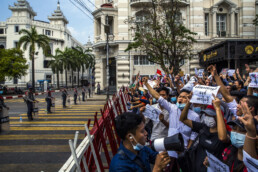
2nd Prize
Mohamed ABED
AFP
Gaza : 11 jours de bombardements
GAZA
3rd Prize
Laurent VAN DER STOCKT
Le Monde
Un mois de soulèvement palestinien
ISRAEL, OCCUPIED WEST BANK, EAST JERUSALEM, GAZA
TELEVISION TROPHY – INTERNATIONAL JURY
AWARDED BY AMNESTY INTERNATIONAL
1st Prize
Orla GUERIN and Goktay KORALTAN
BBC
Les tireurs d’élite au Yémen
YEMEN
2nd Prize
Nick PATON WALSH and Christian STREIB
CNN
Au Belarus, ils voulaient la démocratie. Au lieu de cela, ils disent qu’ils ont été battus et violés par la police.
BELARUS – UNITED KINGDOM
3rd Prize
John SPARKS ans Garwen McLUCKIE
SKY NEWS
La route de Cheli
ETHIOPIA
PHOTO TROPHY – PUBLIC’S CHOICE AWARD
SPONSORED BY THE FRENCH DEVELOPMENT AGENCY (AFD)
1st Prize
Abu Mustafa IBRAHEEM
Reuters
Gaza : 11 jours de bombardements
GAZA
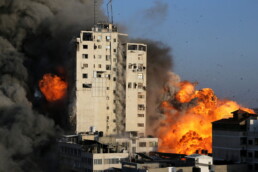
PRINT TROPHY – INTERNATIONAL JURY
AWARDED BY THE DEPARTMENT OF CALVADOS
1st Prize
Wolfgang BAUER
Zeit Magazin
Among Taliban
AFGHANISTAN
2nd Prize
Rémy OURDAN
Le Monde
Guerre au Karabakh
STEPANAKERT, NAGORNO-KARABAKH
3rd Prize
Samuel FOREY
Libération
De Jérusalem à Gaza, Palestine et Israël s’embrasent
JERUSALEM, LOD, ASHKELON, GAZA
RADIO TROPHY – INTERNATIONAL JURY
AWARDED BY THE D-DAY LANDING COMMITTEE
1st Prize
Margaux BENN
EUROPE 1
À Kandhar, des villages entiers sont devenus terrains minés
AFGHANISTAN
2nd Prize
Omar OUAHMANE
FRANCE INTER
Un carnage, deux versions : témoignages après les frappes meurtrières de Bounti
MALI
3rd Prize
Céline MARTELET and Edith BOUVIER
RTS
Des familles syriennes à la recherche de leurs proches
SYRIA
YOUNG REPORTER TROPHY (WRITTEN PRESS) – INTERNATIONAL JURY
AWARDED BY CRÉDIT AGRICOLE NORMANDIE
1st Prize
Thomas D’ISTRIA
Le Monde
Révolution dans la dernière dictature d’Europe
BELARUS
GRAND FORMAT TELEVISION TROPHY – INTERNATIONAL JURY
AWARDED BY BAYEUX CITY
1st Prize
Damir SAGOLJ and Danis TANOVIC
Al Jazeera Balkans
When we were them
BIHAC, BOSNIA-HERZEGOVINA
VIDEO IMAGE TROPHY – INTERNATIONAL JURY
AWARDED BY ARTE, FRANCE 24, FRANCE TÉLÉVISIONS
1st Prize
Damir SAGOLJ and Danis TANOVIC
Al Jazeera Balkans
When we were them
BIHAC, BOSNIA-HERZEGOVINA
PRINT TROPHY – OUEST-FRANCE – JEAN MARIN
1st Prize
Wolfgang BAUER
Zeit Magazin
Among Taliban
AFGHANISTAN
TELEVISION TROPHY – REGIONAL PRIZE FOR STUDENTS AND TRAINEES OF NORMANDY
1st Prize
Orla GUERIN and Goktay KORALTAN
BBC
Les tireurs d’élite au Yémen
YEMEN
Ed Vulliamy, Chair of the jury for the 27th edition
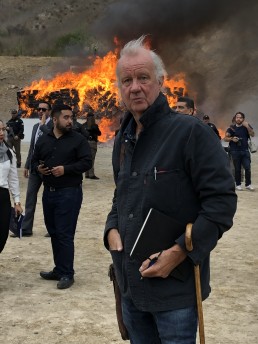
© Jorge Fregoso – Tijuana, Octobre 2019
“I don’t see myself as a war reporter. I see myself as an anti-war reporter”
“I don’t see myself as a war reporter. I see myself as an anti-war reporter”
At the age of almost 66 Ed Vulliamy belongs to what journalists tend to refer to as the “Sarajevo generation”. He covered the conflicts of the 1990s in Slovenia, Croatia and Bosnia, and in Iraq, but it was by no means a foregone conclusion that he would enter the singular profession of war correspondent.
“I hate war: my father was a pacifist and his mother, Irish and a fierce republican who had lived through the war of independence, was too”, he explains. “But war keeps coming to me.” As a student of politics and philosophy at the university of Oxford, the young Ed was deeply affected by the events taking place in Northern Ireland. The Troubles provided a natural subject for his thesis, which became his first “war report”. After leaving university he joined the team of World in Action, the investigative current affairs programme produced by English regional channel ITV Granada (formerly Granada TV), and spent eight years covering the conflict in Northern Ireland for the programme. His first area of specialisation also led to his first awards, with one of his many documentaries earning him the Royal Television Society award in 1985. He left to go to Italy, to investigate and cover organised crime in Europe’s famous “Boot”. His employer the Guardian, with whom he would continue to work throughout his whole career, asked him to “keep an eye on Yugoslavia” from Italy. In the end Ed would keep more than an eye on the Balkans: between 1991 and 1995 he spent most of his time in this region racked by successive conflicts. The journalist who had “become a war reporter by accident” received numerous awards for his work in this perilous zone. Having witnessed some of the worst atrocities, Ed Vulliamy would provide testimony in 2006 at the International Criminal Court in The Hague, in Holland, corroborated by footage filmed in the concentration camps for his documentary Omarska’s Survivors: Bosnia 1992. Facing him in the dock was Slobodan Prajlak, the man who had received him at the Dretelj camp 13 years earlier. At that moment the “accidental“ war reporter became the first journalist since the Nuremberg trials to testify in a war crimes tribunal.
“I don’t really go to war, war comes to me”
“I don’t really go to war, war comes to me”
At the end of the 1990s it was “Ciao, Italia!” Ed left for the United States where The Observer, sister title to The Guardian, had asked him to be its U.S. correspondent. He had already covered many topics in America for the British Sunday paper during the 1990s. This time he was able to return to his speciality, investigating organised crime and drug trafficking along the U.S.-Mexican border. The result was the book Amexia, War Along the Borderline, which received the prestigious Ryszard Kapuscinski Award in 2013. In 2001, when he was based in New York, he found himself in the front line when the attacks on the World Trade Center took place: once again “war came to [him]”. He later covered the conflict in Iraq for The Observer but had found himself “censored or ignored” when he tried to publish articles bringing to light the false information being propagated prior to the war and the non-existence of weapons of mass destruction. His determination and desire to reveal the truth are portrayed in Gavin Hood’s 2019 film Official Secrets, where he is played by the Welsh actor Rhys Ifans.
“To be a good journalist and especially a good war reporter, you have to be a little mad”
“To be a good journalist and especially a good war reporter, you have to be a little mad”
When asked how a journalist who has become a war correspondent by accident can be so committed and driven, Ed Vulliamy turns the question round: “What else to do?” He adds, with modesty, “It is our job to write or film the truth, however uncomfortable that is. In fact I think that’s how we measure professionalism in our work: by doing the best we can.” Measuring professionalism: that’s the big challenge in his upcoming role as chair of the international jury of the 27th Bayeux award for war correspondents. The journalist – who also writes articles and books on such diverse topics as football, painting and music – admits to feeling nervous: “I hope I’ll be up to it. It’s the Oscars of war reporting! It’s a huge responsibility and I’m honoured”.
“I think our definition of war may change as the 21st Century proceeds.
The wars my brave and amazing colleagues have mostly covered are like the wars of history, dragged into our time.
But what are we to make of new kinds of war in, say, Mexico, where the death toll is three times that of Bosnia, and the number of disappeared 50 per cent higher than all the Balkan wars, 1991-9? Yet in this war, which has killed more journalists than any other – people go to market, to school, to Mass; the football league functions well, the universities are good – war in apparent ‘peacetime’. What are we to call the gangland battlefields of El Salvador and Honduras, and refugees from ‘drugs wars’?
Academics use the term ‘slow violence’ to describe many of the world’s conflicts. Young people – journalists, readers and viewers – will include refugees and migration from climate crisis, and future wars over water and resources, as wars as much as any other – part of that time-long war between humankind and nature that will dominate coming generations. What are we to call the violent obliteration of the last indigenous existences, and assaults on indigenous lands and minorities? Journalists are being killed for reporting these stories too.
Where does systematic violence against women fit in to our definitions of war: femicidio in the Americas, the cult of gang rape in India?
That “war between the man and the woman*’ as Leonard Cohen called it!
We cannot call all violence ‘war’ – that would be ridiculous – and focus on warfare is what raises Bayeux to a level of honour above all other awards for journalism.
But I do think young people will want us to be less conventional with regard to what we call ‘War’, and, logically, war reporting.” — Ed Vulliamy
1954 ❱ Ed Vulliamy was born in Notting Hill, London
1979 ❱ Joined English regional channel ITV Granada (formerly Granada TV)
1985 ❱ Won the RTS Journalism Award for his documentary on Ireland
1986 ❱ Joined British newspaper The Guardian
1991 ❱ Covered the war in Iraq
1991-1995 ❱ Covered the wars in the Balkans
1992 ❱ Granada Television’s What the Papers Say Foreign Correspondent of the Year
1992 ❱ British Press Awards International Reporter of the Year
1992 ❱ Amnesty International Media Award
1994 ❱ James Cameron Award
1997 ❱ British Press Awards International Reporter of the Year
2001 ❱ Covered the 11 September attacks in New York
2003-2006 ❱ Covered the war in Iraq
2006 ❱ Became the first reporter since the Nuremberg trials to testify before the International Criminal Court in the Hague
2013 ❱ Won the Ryszard Kapuscinski Award for his book Amexica: War Along The Borderline
2015 ❱ Publication of the book Everything Is Happening: Journey into a painting on the masterpiece by Velázquez. He had completed the book for his friend, author Michael Jacobs.
2016 ❱ Nominated for the Ryszard Kapuscinski Award for his book The War Is Dead, Long Live the War, Bosnia: The Reckoning.
2018 ❱ Publication of the book When words fail: a life with music, war and peace (Louder Than Bombs in the United States)
2019 ❱ Was played by actor Rhys Ifans in Gavin Hood’s film film Official Secrets
2020 ❱ Made an Honorary Fellow of Goldsmiths College, London
2020 ❱ Second, updated edition of the book Amexica: War Along he Borderline, ten years after its first publication
Call for candidates
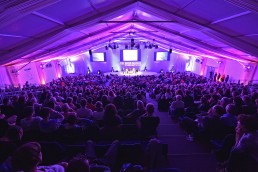
The Bayeux Calvados-Normandy award for war correspondents rewards reports about a conflict situation or its impact on civilians, or news stories involving the defence of freedom and democracy.
The report must have been made between 1 June 2019 and 31 May 2020. A €7,000 prize is awarded in each category.
The reports must be submitted to the following address by June 15th 2020: info@prixbayeux.org with a link to download the entry
The categories of media represented are: radio – photography – television (short and long formats) – written press and the young reporter prize (photo this year)
TEN PRIZES ARE AWARDED
Seven prizes awarded by the international jury
- Written Press Prize sponsored by the Calvados Department – €7,000
- Television Prize sponsored by Amnesty International- €7,000
- Radio Prize sponsored by the D-Day Landing Committee – €7,000
- Photo Prize sponsored by Nikon – €7,000
- Grand format Television Prize sponsored by the town of Bayeux – €7,000
- Young reporter Prize sponsored by Crédit Agricole Normandie – €3,000
- Video image prize sponsored by Arte, France 24 and France Télévisions – €3,000
Three special prizes
- The Ouest-France – Jean Marin Prize (written press) – €4,000
- The Public Prize (photo) sponsored by the Agence Française de Développement – €3,000
- The Normandy Region secondary School Students’ Prize (television) – €3,000
REGULATIONS
• The Young Reporter’s Award: in 2020: the category is photo. Since there is a different category according to the years, the presented story must have been realized between 1 June 2018 and 31 May 2020.
• Written press category: the application must be made up of an article or a series of 1 to 5 articles on the same subject.
• Television category: the length of the report must be between 1 minute 30 seconds and 6 minutes. The report submitted must be identical to the broadcast piece.
• Grand format television category: the length of the report must be between 6 and 30 minutes. The report submitted must be identical to the broadcast piece.
• Radio category: the length of the report must be between 1 minute and 6 minutes. The report submitted must be identical to the broadcast piece.
• Photo category: The application comprises a report made up of 8 to 15 photos.
Workshop Nikon – Le Manoir

With over a century of existence and by virtue of its values and commitment, supporting photojournalists is part of Nikon’s DNA.
In the framework of the Bayeux award for war correspondents, the brand offers to pay for 12 participants for the training "REPORT IN DANGEROUS ZONES" of the Manoir created by France Médias Monde.
In association with INA (the French national audiovisual archive) and with the support of Reporters without borders, the Manoir will soon have trained almost 360 reporters and information technicians and collaborates with many media like Le Monde newspaper, Arte, Canal + and the French public television channels, among others. The training provided by the Manoir is now recognised as the reference standard in its field.
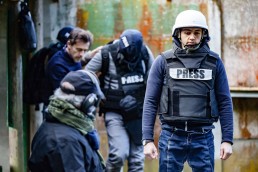
While it is obvious that research and information-sharing are essential, the safety of journalists on assignment has to be both the primary concern and the starting point in the editorial process.
Because the journalist is the principal player in his or her own safety, the Manoir provides specific training and methodologies given by journalists to journalists, and brings in leading experts in the fields of health, emergency rescue and psychology.
The effects of weapons, the dangers of mines and orientation skills are also taught by expert practitioners who are experienced in training news professionals.
By the end of the training course, the journalist situated in a danger zone is able to assess risks more accurately, to understand critical situations and to react more adroitly to accidents in the field.
By partnering with the Manoir, Nikon wants to support talented young photojournalists in the exercise of their profession by giving them the best possible training.
To apply, candidates must send their entry, including a CV, a motivation letter and one or more productions of a photo report produced in dangerous zones, to securite.academie@francemm.com before August 30, 2020.
Visual
The 2020 visual is a photo from the 2019 winning report. This photograph taken by Patrick Chauvel for Paris Match, was part of his report shot in Baghuz, Syria in March 2019.
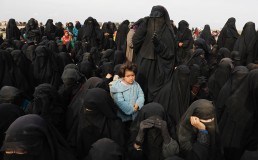
Caption: A little girl amid Jihadists’ wives assembled in the desert by the Kurds.
Patrick Chauvel
For over fifty years, Patrick Chauvel has photographed most of the conflicts around the world. He is one of the last of a generation of reporters who lived the Six Day War, Vietnam, Cambodia, Ireland, Iran, Lebanon, Panama, Afghanistan, Israel, Chechnya, Syria… His images have made the front page of the most prestigious media in the world. Author of numerous documentaries, he also wrote a book on the life of war reporter, success of bookstores: Rapporteur de guerre.
© Bayeux Award photo 2019 – Patrick Chauvel
26th edition of the Bayeux Calvados-Normandy Award: results
More than forty war correspondents have gathered in Bayeux on October 11th and 12th to debate and award trophies in the following categories: photo, print, radio, television, grand format television, young reporter (print) and video image. Three honorary awards have been attributed: the Regional prize for students and trainees of Normandy (television), the Public’s Choice award (photo) and the Ouest-France – Jean Marin prize (print). Presided by Gary Knight, the international jury of the 26th edition of the Bayeux Calvados-Normandy Award for war correspondents has reached its verdict…
“In every category, the jury converged on a few stories, there wasn’t a lot of dispute. We had a really great conversation amongst the jury, interesting, lively and with very good humour. Plus it is wonderfull to see my colleagues and it is also great to know what they have to say about that work. We can challenge each other and I love having this conversations. It makes it all smarter.“
Gary Knight
PHOTO TROPHY – INTERNATIONAL JURY
AWARDED BY NIKON
1st Prize
Patrick CHAUVEL
Freelance for PARIS MATCH
Syrie, la fin de Baghouz
SYRIA
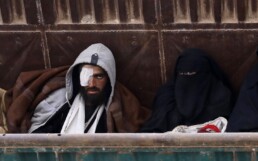
2nd Prize
Rodrigo ABD
ASSOCIATED PRESS
A caravan
MEXICO
3rd Prize
Andrew QUILTY
AGENCE VU
Quand la guerre rentre à la maison
AFGHANISTAN
TELEVISION TROPHY – INTERNATIONAL JURY
AWARDED BY AMNESTY INTERNATIONAL
1st Prize
Orla GUERIN, Lee DURANT and Nicola CAREEM
BBC NEWS
Yémen : un bus touché par une frappe aérienne
YEMEN
2nd Prize
John SUDWORTH and Wang XIQING
BBC NEWS
Les camps d’internement pour les musulmans en Chine
CHINA
3e Prix
Fausto BILOSLAVO
RETE 4
Guerre en Libye
LIBYA
PHOTO TROPHY – PUBLIC’S CHOICE AWARD
SPONSORED BY THE FRENCH DEVELOPMENT AGENCY (AFD)
1st Prize
Patrick CHAUVEL
Freelance for PARIS MATCH
Syrie, la fin de Baghouz
SYRIA

PRINT TROPHY – INTERNATIONAL JURY
AWARDED BY THE DEPARTMENT OF CALVADOS
1st Prize
Fritz SCHAAP
Der Spiegel
An epidemic and a war
DEMOCRATIC REPUBLIC OF CONGO (DRC)
2nd Prize
Wolfgang BAUER
Die Zeit
L’ordre
AFGHANISTAN
3rd Prize
Maggie MICHAEL
ASSOCIATED PRESS
Yémen, la sale guerre
YEMEN
RADIO TROPHY – INTERNATIONAL JURY
AWARDED BY THE D-DAY LANDING COMMITTEE
1st Prize
Sami BOUKHELIFA
RFI
Voyage au bout du califat
SYRIA
2nd Prize
Sophie PARMENTIER
France INTER
Françaises, mère et fille, dans une prison de Bagdad
IRAQ
3rd Prize
Matthieu MONDOLONI
France INFO
Kinan, l’enfant esclave de Daech
SYRIA-IRAQ
YOUNG REPORTER TROPHY (PRINT) – INTERNATIONAL JURY
AWARDED BY CRÉDIT AGRICOLE NORMANDIE
1st Prize
Wilson FACHE
L’ORIENT-LE JOUR / THE NATIONAL NEWSPAPER / VICE
Gaza, année noire
GAZA
GRAND FORMAT TELEVISION TROPHY – INTERNATIONAL JURY
AWARDED BY BAYEUX CITY
1st Prize
Clément GARGOULLAUD and Shafat FAROOQ
Babel Press for Arte Reportage
Cachemire : les visages de la colère
INDIA
VIDEO IMAGE TROPHY – INTERNATIONAL JURY
AWARDED BY ARTE, FRANCE 24, FRANCE TÉLÉVISIONS
1st Prize
Clément GARGOULLAUD
Babel Press for Arte Reportage
Cachemire : les visages de la colère
INDIA
PRINT TROPHY – OUEST-FRANCE – JEAN MARIN
1st Prize
Fritz SCHAAP
Der Spiegel
An epidemic and a war
DEMOCRATIC REPUBLIC OF CONGO (DRC)
TELEVISION TROPHY – REGIONAL PRIZE FOR STUDENTS AND TRAINEES OF NORMANDY
1st Prize
Leo RAMIREZ, Jesus OLARTE, Yorman MALDONADO, Carlos REYES, Natasha VAZQUEZ and Edinson ESTUPINAN
AFP TV
Venezuela: crisis at the border
VENEZUELA
25th edition of the Bayeux Calvados-Normandy Award: results
Fifty war correspondents have gathered in Bayeux on October 12th and 13th to debate and award trophies in the following categories: photo, print, radio, television, grand format television, young reporter (photo) and video image. Three honorary awards have been attributed: the Regional prize for students and trainees of Normandy (television), the Public’s Choice award (photo) and the Ouest-France – Jean Marin prize (print). Presided by Christiane Amanpour, the international jury of the 25th edition of the Bayeux Calvados-Normandy Award for war correspondents has reached its verdict…
“I am proud to be in Bayeux and to chair the international jury of the 25th Bayeux Calvados-Normandy Award for war correspondents. The entries are extremely powerful and of a very high quality. It was a pleasure to watch them with my colleagues, discuss them, debate and vote.“
Christiane Amanpour
PHOTO TROPHY – INTERNATIONAL JURY
AWARDED BY NIKON
1st Prize
Mahmud HAMS
AFP
Clashes on Gaza’s border
PALESTINE
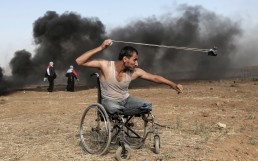
2nd Prize
Laurent VAN DER STOCKT
LE MONDE
La vieille ville de Mossoul : la bataille contre le dernier bastion de Daesh
IRAQ
3rd Prize
Juan BARRETO
AFP
Venezuela: anti-government protests
VENEZUELA
TELEVISION TROPHY – INTERNATIONAL JURY
AWARDED BY AMNESTY INTERNATIONAL
1st Prize
Nima ELBAGIR, Alex PLATT and Raja RAZEK
CNN
Libya Slave Auction
LIBYA
2nd Prize
Clive MYRIE and Darren CONWAY
BBC
Mexico’s drug war
MEXICO
3e Prix
Jonathan HEAD and Daniel BULL
BBC
Rohingya
BANGLADESH
PHOTO TROPHY – PUBLIC’S CHOICE AWARD
SPONSORED BY THE FRENCH DEVELOPMENT AGENCY (AFD)
1st Prize
Paula BRONSTEIN
GETTY IMAGES REPORTAGE
The Rohingya crisis: a harrowing journey
BANGLADESH
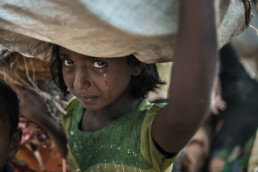
PRINT TROPHY – INTERNATIONAL JURY
AWARDED BY THE DEPARTMENT OF CALVADOS
1st Prize
Kenneth R. ROSEN
THE ATAVIST MAGAZINE
The Devil’s Henchmen
IRAQ
2nd Prize
Wolfgang BAUER
ZEITMAGAZIN INTERNATIONAL
The poison of war
SUDAN
3rd Prize
Rukmini CALLIMACHI
THE NEW YORK TIMES
La méthode Daech, ou l’administration par la terreur
IRAQ
RADIO TROPHY – INTERNATIONAL JURY
AWARDED BY THE D-DAY LANDING COMMITTEE
1st Prize
Gwendoline DEBONO
EUROPE 1
Ni prisonnières, ni réfugiées : femmes djihadistes en Syrie
SYRIA
2nd Prize
Julie PIETRI
FRANCE INTER
Rohingyas, l’enfer de la traversée
BANGLADESH
3rd Prize
Martin PATIENCE
BBC
Survivre à une tempête de neige syrienne
SYRIAN BORDER (LEBANON)
YOUNG REPORTER TROPHY (PHOTO) – INTERNATIONAL JURY
SPONSORED BY CAPA PRESSE TV
1st Prize
Mushfiqul ALAM
FREELANCE
The Great Exodus
BANGLADESH
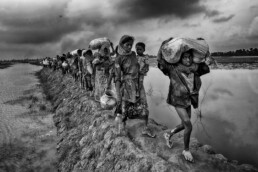
GRAND FORMAT TELEVISION TROPHY – INTERNATIONAL JURY
AWARDED BY SCAM
1st Prize
Nicolas BERTRAND and Thomas DONZEL
FRANCE 2
Rohingyas : les damnés de la Birmanie
MYANMAR and BANGLADESH
VIDEO IMAGE TROPHY – INTERNATIONAL JURY
SPONSORED BY Bew TV / FRANCE 24 / ARTE
1st Prize
Darren CONWAY
BBC
Mexico’s drug war
MEXICO
PRINT TROPHY – OUEST-FRANCE – JEAN MARIN
1st Prize
Jean-Philippe REMY
LE MONDE
Le Yémen en guerre
YEMEN
TELEVISION TROPHY – REGIONAL PRIZE FOR STUDENTS AND TRAINEES OF NORMANDY
1st Prize
Stéphanie PEREZ, Nicolas AUER and Laetitia NIRO
FRANCE 2
Les lionceaux du Califat : des bombes à retardement ?
IRAQ


